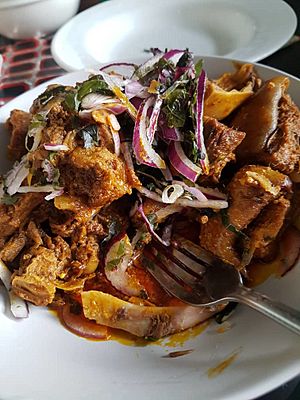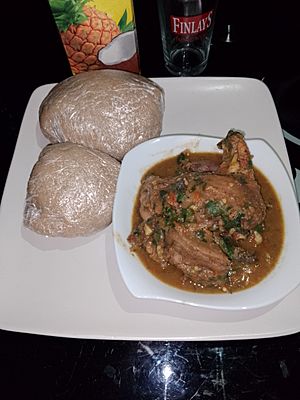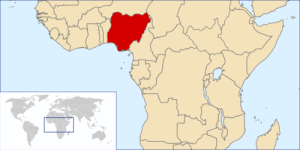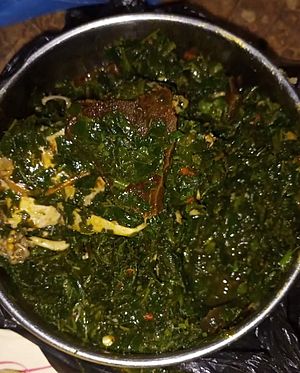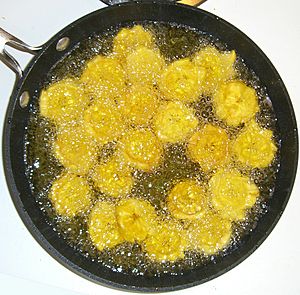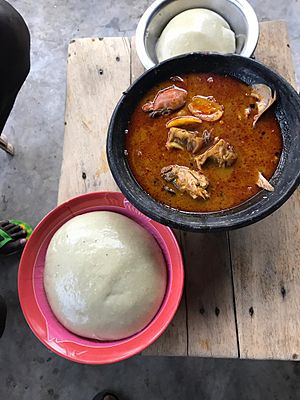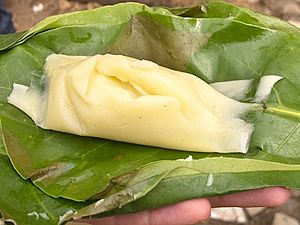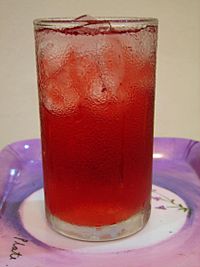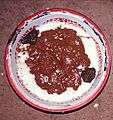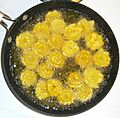Nigerian cuisine facts for kids

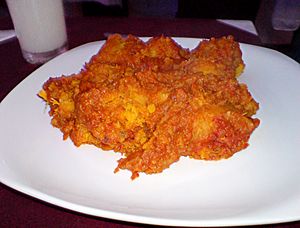
Nigerian cuisine is all about the delicious food from the many different ethnic groups in Nigeria. Just like other foods in West African cuisines, it uses lots of spices and herbs. People often cook with palm oil or groundnut oil to make rich and flavorful sauces and soups.
Nigerian celebrations often feature colorful and grand meals. You can also find many tasty snacks cooked on barbecues or fried in oil along the roadsides and in markets. Tropical fruits like pineapple, coconut, banana, and mango are also very popular in Nigeria. One thing to know about Nigerian food is that it's often quite spicy!
Contents
Main Meals
Rice Dishes
- Coconut rice is made with coconut milk and other spices, giving it a sweet and savory taste.
- Jollof rice is a very famous rice dish. It's cooked in a sauce made from pureed tomatoes and spicy Scotch bonnet peppers.
- Ofada rice is a special kind of rice from Southwestern Nigeria. It's usually eaten with a unique sauce called Ayamase or Ofada sauce.
- Fried rice is a rich dish that includes mixed vegetables like cabbage, carrots, and green peas. It often has meat, chicken, or prawns mixed in.
- Pate is made from ground dry corn, rice, or acha. It's often cooked with vegetables like spinach, tomatoes, onions, and peppers. This dish is popular in northwestern Nigeria.
- Tuwo masara is a corn-flour dish eaten in Northern Nigeria.
- Tuwo shinkafa is a thick rice pudding. It's usually served with miyan kuka (a thick soup) and goat meat stew, or miyan taushe, which is a pumpkin stew with spinach and meat. It's mostly eaten in the northern part of the country.
- White rice is commonly served with different stews and sauces. A popular way to eat it is with a thick tomato and pepper-based stew.
- Banga rice is a traditional Nigerian rice recipe made with palm nut extract and rice. It's very common in the southern and eastern parts of the country.
- Palm-oil rice is often called 'local rice'. It's prepared with fresh palm oil, different kinds of fish (dried or smoked), and local spices like locust beans. It can be made as a jollof style dish or as white rice with the palm oil stew served separately.
Bean Dishes
- Akara is a type of fritter made from beans. It's crispy on the outside and soft inside.
- Moi moi is a steamed bean pudding. It's made from a mix of washed and peeled black-eyed beans, onions, and fresh red peppers.
- Ewa aganyin is boiled beans served with a spicy pepper sauce. It's a favorite in South West Nigeria.
- Okpa is a common breakfast food in Southeastern Nigeria. It's made from Bambara nut flour.
- Adalu is a tasty pottage made from beans and sweet corn. It's popular in South West Nigeria.
Corn Dishes
- Egbo is a special Yoruba dish. It can be eaten by itself with pepper sauce or paired with beans.
Meat Dishes
Meat is a big part of most Nigerian meals.
- Suya comes from northern Nigeria. It's grilled meat coated with ground chili pepper, peanut powder, and other local spices. It's cooked like a barbecue on a stick. Suya is one of Nigeria's most famous foods and you can find it easily almost everywhere.
- Kilishi is like beef jerky. It's made from very thin slices of meat that are dried. Then, a paste of chili pepper, spices, and local herbs is brushed on both sides before it's briefly grilled.
- Nkwobi is a classic dish from southeastern Nigeria. It's made of cooked cow legs covered in a thick, spicy palm oil sauce.
- Asun is spicy roasted goat meat cut into small pieces. It has strong flavors from onions, habanero peppers, Garlic, and bell peppers. It's a traditional dish of the Yoruba people in Ondo, South Western Nigeria.
Soups and Stews
- Banga soup is made from palm nuts. It's mostly eaten in the southern and mid-western parts of Nigeria. This soup is usually served with a 'swallow' food like garri or pounded yam.
- Miyan kuka is very common among the Hausa people. It's made from powdered baobab leaves and dried okra.
- Ewedu soup is popular with the Yoruba people of south-western Nigeria. It's usually made with jute leaves, which are pureed to make the soup thick.
- Edikang-ikong is a vegetable soup made from ugwu (pumpkin) leaves and waterleaf. It comes from the Annang, Ibibio, and Efik people.
- Gbegiri is a bean-based stew from southwest Nigeria. It's often eaten with Amala.
- Pepper soup is a light soup made with a mix of meat or fish, herbs, and spices. It's one of the few Nigerian soups that can be eaten alone, not just as a sauce for a main dish like fufu or pounded yam. It's often enjoyed at social gatherings.
- Afang is a vegetable soup from the Efik people, Ibibio people, and Ananng people in southeast Nigeria. It's made with waterleaf, afang leaves, and lots of assorted meat and fish.
- Okro soup (or okoroenyeribe) is made from okra and cooked until it becomes thick and 'draws' (stretches).
- Efo riro is a stew made from leafy vegetables, pepper, palm oil, and other ingredients. It's common among the Yorubas.
- Egusi soup is thickened with ground melon seeds and contains leafy vegetables, seasonings, and meat. It's often eaten with dishes like amala, pounded yam (iyan), or fufu.
- Miyan taushe is a great mix of groundnut and pumpkin leaves spiced with pepper and seasonings. It's best enjoyed with tuwo shinkafa.
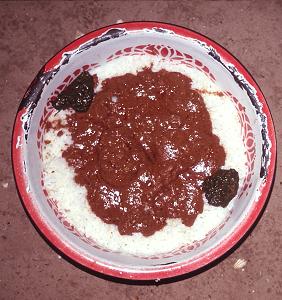
- Maafe is a stew made with groundnuts (peanuts), tomatoes, and onions as its base. You can add chicken, beef, or fish and different leafy vegetables for various flavors.
- Ogbono soup is made with ground ogbono seeds, leafy greens, other vegetables, seasonings, and meat. It's also eaten with 'swallow' foods like pounded yam or amala.
- White soup, also called ofe nsala, is made with utazi leaves.
- Bitterleaf soup (ofe onugbu) is made with cooked and pounded cocoyam, palm oil, and fresh bitterleaf that has been mashed to remove its bitterness.
- Ofada stew (Ayamase) is a palm-oil-based stew from the Yoruba people of South western Nigeria. It's made with palm oil, unripe peppers, tomatoes, beef, and cow skin. It's usually served with local ofada rice.
- Groundnut soup (Peanut soup) is made from fresh ground peanuts, onions, and bell pepper. It's cooked with palm oil, meat stock, crayfish, and other fish or meat, then finished with leaves like pumpkin or bitterleaf.
- Ora (Oha) soup is made with cooked and pounded cocoyam, palm oil, assorted fish, meat, pepper, and seasonings.
- Ofe owerri is prepared with four kinds of vegetable leaves: okazi, ugu, uziza, and oha leaves. A special cocoyam is used to make the soup thick. This vegetable soup is common among the Igbos of eastern Nigeria.
Side Dishes
- Dodo is a side dish of plantains fried in vegetable or palm oil. Ripe plantains are usually preferred.
- Gizdodo is a mix of fried Dodo and grilled gizzard.
- Peppered gizzard is a spicy snack made from gizzards.
- Funkaso are millet pancakes.
- Masa is fermented corn ground into a thick paste, fried, and then sprinkled with sugar.
- Plantain chips are a crunchy, salty or sweet Nigerian snack. They are made from either ripe or unripe plantains fried in vegetable oil.
- Potato chips are also a common snack.
Puddings, Pastes, and Porridges
- Moin moin is a savory steamed bean pudding. It's made from peeled black-eyed peas and often wrapped in a leaf, like a banana leaf.
- Plantain pudding is commonly known as okpo ogede.
- Corn pudding is locally known as okpo oka.
- Pap or ogi (also called akamu) is a soft pudding made from guinea corn, millet, or corn.
Yam Dishes
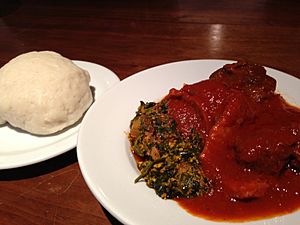
- Iyan is similar to mashed potatoes but it's completely smooth with no yam chunks left. It's usually eaten with soups.
- Amala is a thick paste made from yam that has been peeled, dried, and then blended. It's usually darker (brown) in color than iyan.
- Yam pottage is a popular homemade meal in eastern and southern Nigeria. It's called Asaro by the Yorubas. It's made by boiling and lightly mashing yam in a rich tomato, chili, and pepper sauce with palm oil.
- Ebiripo is common among the Remo people in South-West Nigeria. It's made by grating cocoyam into a paste, adding salt and groundnut oil, and then boiling it in leaves. It's usually eaten with soups like efo riro.
- Ikokore is a popular dish in the Ijebu areas of South-West Nigeria. It's similar to asaro but uses water yam instead of regular yam.
Cassava Dishes
- Eba (also called garri) is a very thick paste made from cassava. It's often rolled into balls or served like amala and eaten with soups.
- Fufu is a staple dish in Nigeria and most of West Africa. It's a soft, dough-like food often eaten with soups.
- Lafun is similar to amala but much lighter in color. It's made from cassava.
Breakfast Foods
- Sinasir is a flat masa. It's made by pouring prepared rice paste into a frying pan. This is a common Hausa food.
- Alkubus is a Hausa-Fulani steamed bread made from wheat, flour, yeast, and water. It's steamed in molds and served with miyan taushe.
- Eko (also known as agidi) is a popular breakfast meal in Nigeria. It's often served with other foods like Akara (fried bean cake), beans, or pepper soup.
- Ogi or akamu is a corn pudding common in Nigeria. It's called ogi by the Yoruba people and akamu by the Igbo people. It's often eaten with bread, akara, or beans.
Snacks
- Chin chin are fried cookie strips made from flour, eggs, and butter. They are crunchy and sweet.
- Puff-puff are fried sweet dough balls. They are soft and airy inside.
- Buns are another type of fried sweet dough ball snack, similar to puff-puff but without yeast.
- Akara is a beignet (fritter) made from a batter of black-eyed peas. It's sometimes eaten for breakfast.
- Kuli-kuli is a crunchy snack made from ground peanuts.
- Kokoro is a fried dry snack made from corn and garri (cassava).
- Meat pie is a pastry case filled with beef and vegetables.
- Plantain chips are a crunchy, salty or sweet Nigerian snack made with either ripe or unripe plantains fried in vegetable oil.
- Aadun is made from cornflour, chili pepper, and palm oil.
- Dundu is a Yoruba meal of roasted or deep-fried slices of yam. It's usually eaten with a sauce made of groundnut or palm oil, tomatoes, chili peppers, and seasoning.
- Ojojo is a Yoruba beignet made from grated water yam. Peppers, onions, and seasoning are mixed with the grated yam before it's deep-fried.
Drinks
- Kunu is a very popular drink made from either millet, sorghum, or maize.
- Fura is a popular drink, especially in northern Nigeria. It's made from cooked and pounded millet or sorghum mixed with a little cow's milk.
- Palm wine is a traditional alcoholic drink made from the sap of palm trees. It can also be distilled into a stronger drink called ogogoro.
- Zobo (hibiscus leaf) is a refreshing drink made from roselle juice.
- Soya bean milk is a drink made from soaked, ground, and sieved soya beans.
Images for kids
-
A plate of pounded yam (iyan) and egusi with tomato stew.
See also
 In Spanish: Gastronomía de Nigeria para niños
In Spanish: Gastronomía de Nigeria para niños


